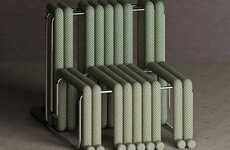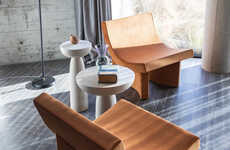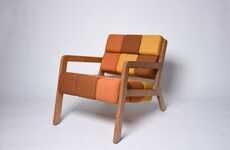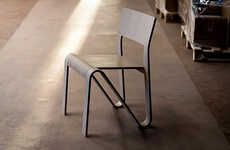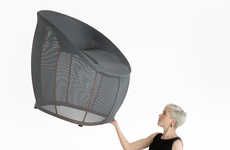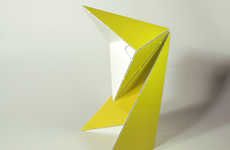
The LAGO Curly Chair is an Adaptable Perch of Pleated Cloth
Amelia Roblin — November 13, 2011 — Art & Design
References: industrialdesignserved
The structure of most seats has little to do with the decorative upholstery sewn on top of metal, wood and stuffing but the LAGO Curly Chair relies rather heavily on the support that its fabric affords. The fetching piece of furniture is quite simply composed of two materials including the lightweight wire framework and the winsome cloth sling so that every part of the object has a practical function.
However, designer Velichko Velikov took the opportunity to employ an ornate powder blue fabric to give the recliner a little class. It's woven onto the white skeleton and can be washed and replaced with another textile. The length of cloth for the furnishing's seat and backrest was also cut unnecessarily long which has caused a charming puckering texture, further contributing to the delight of the LAGO Curly Chair.
However, designer Velichko Velikov took the opportunity to employ an ornate powder blue fabric to give the recliner a little class. It's woven onto the white skeleton and can be washed and replaced with another textile. The length of cloth for the furnishing's seat and backrest was also cut unnecessarily long which has caused a charming puckering texture, further contributing to the delight of the LAGO Curly Chair.
Trend Themes
1. Adaptable Fabric Furniture - There is an opportunity for furniture designers to incorporate more adaptable fabric-based materials to add practicality and comfort, while also offering unique aesthetic options.
2. Functional Fabric Design - The integration of fabric materials with functional frameworks presents opportunities for architects, designers, and engineers to create innovative products with increased strength, durability, and aesthetic appeal.
3. Textile-based Solutions - The application of textiles in furniture and product design provides opportunities to improve comfort, sustainability, and versatility, such as using sustainable textiles or enabling customizable designs.
Industry Implications
1. Furniture Design - There is a chance for furniture designers to reinvent traditional furniture by using adaptable fabric materials and functional frameworks.
2. Textile Manufacturing - Innovations in functional fabrics and sustainable materials are essential for textile manufacturing companies to adapt to changing consumer and market demands.
3. Architecture and Interior Design - By incorporating adaptable fabric-based materials, architects and interior designers can create products with enhanced comfort, practicality, and durability, which meet specific client requirements.
1.1
Score
Popularity
Activity
Freshness


